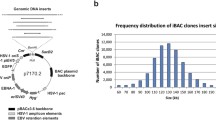Abstract
The increasing accumulation of genomic sequence information has accentuated the need for new methods to efficiently assess gene function and to prepare reagents to study these functions. Toward solving this general problem in functional genomics, we report a method by which any PCR-amplified open-reading frame (ORF) can be noncovalently linked to a eukaryotic promoter and terminator, and directly injected into animals to produce local gene expression. We also demonstrate that ORFs can be delivered into mice to produce antibodies specific for the encoded foreign protein by simply attaching mammalian promoter and terminator sequences. This technology makes it possible to screen large numbers of genes rapidly for their functions in vivo or to produce immune responses without the necessity of cloning, bacterial propagation, or protein purification.





Similar content being viewed by others
References
Xie, T.D. & Tsong, T.Y. Study of mechanisms of electric field-induced DNA transfection. Biophys. J. 65, 1684–1689 (1993).
Buttrick, P.M., Kass, A. & Kitsis, R.N. Behavior of genes directly injected into the rat heart in vivo. Circ. Res. 70, 193– 198 (1992).
Sanford, J. et al. An improved, helium-driven biolistic device. Technique 3, 3–16 (1991).
Nisson, P.E., Rashtchian, A. & Watkins, P.C. Rapid and efficient cloning of Alu-PCR products using uracil DNA glycosylase. PCR Methods and Applications 1, 120–123 (1991).
Williams, R.S. et al. Direct transformation of skin and liver tissue in the living mouse. Proc. Natl. Acad. USA 88, 2726– 2730 (1991).
Wolff, J.A. et al. Direct gene transfer into mouse muscle in vivo. Science. 246,1464–1468 (1990).
Tang, D.-C., DeVit, M. & Johnston, S.A. Genetic immunization is a simple method for eliciting an immune response. Nature 356, 152– 154 (1992).
Barry, M.E. Barry, M.A. & Johnston, S.A. Production of monoclonal antibodies by genetic immunization. Biotechnology 16, 616– 620 (1994).
Laqueyrerie, A. et al. Cloning, sequencing, and expression of the apa gene coding for the Mycobacterium tuberculosis 45/47-kilodalton secreted antigen complex. Infect. Immun. 63, 4003– 4010 (1995).
Sato, Y. et al. Immunostimulatory DNA sequences necessary for effective intradermal gene immunization. Science 273, 352–354 (1996).
Barry, M.A., Lai, W.C. & Johnston, S.A. Protection against Mycoplasma infection using expression library immunization. Nature 377, 632– 635 (1995).
Andersson, S., Davis, D.N., Dählback, H., Jörnvall, H. & Russell, D.W. Cloning structure and expression of the mitochondrial cytochrome P-450 sterol 26-hydroxylase, a bile acid biosynthetic enzyme. J. Biol. Chem. 264, 8222– 8229 (1989).
Long, G.L., Chandra, T., Woo, S.L., Davie, E.W. & Kurachi, K. Complete sequence of the cDNA for human alpha 1-antitrypsin and the gene for the S variant. Biochemstry 23, 4828–4837 (1984).
Fisher, R. et al. Isolation and characterization of the human tissue-type plasminogen activator structural gene including the 5´ flanking region. J. Biol. Chem. 260, 11223–11230 ( 1985).
Harlow, E. & Lane, D. Antibodies: A Laboratory Manual (Cold Spring Harbor Laboratory Press, Cold Spring Harbor, NY, 1988).
Acknowledgements
We thank Mike Barry for initial observation of PCR-product encoded gene expression and colleagues at the Center for Biomedical Inventions for encouragement and discussion. This work was supported by a grant from DARPA to S.A.J.
Author information
Authors and Affiliations
Corresponding author
Rights and permissions
About this article
Cite this article
Sykes, K., Johnston, S. Linear expression elements: a rapid, in vivo, method to screen for gene functions. Nat Biotechnol 17, 355–359 (1999). https://doi.org/10.1038/7908
Received:
Accepted:
Issue Date:
DOI: https://doi.org/10.1038/7908
- Springer Nature America, Inc.
This article is cited by
-
Polyclonal Antibody Production for Membrane Proteins via Genetic Immunization
Scientific Reports (2016)
-
A Novel Terminator Primer and Enhancer Reagents for Direct Expression of PCR-Amplified Genes in Mammalian Cells
Molecular Biotechnology (2015)
-
Novel immune-modulator identified by a rapid, functional screen of the parapoxvirus ovis (Orf virus) genome
Proteome Science (2012)
-
Histone Modifications are Associated with the Persistence or Silencing of Vector-mediated Transgene Expression In Vivo
Molecular Therapy (2007)
-
High throughput production, screening and analysis of adeno-associated viral vectors
Gene Therapy (2000)





